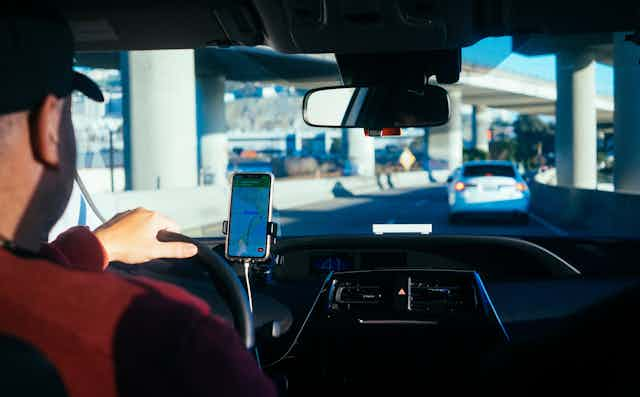The driving profession is unsafe. Taxi drivers and ride-hail drivers, who drive for apps like Uber and Lyft, face many safety risks on the road, from accidents and injuries to harassment and violence.
In fact, 83 per cent of ride-hail drivers from around the world feel their work is unsafe. As a result, 22 per cent of American drivers carry weapons in their vehicles to protect themselves.
Our recent research study aimed to examine whether low income, lack of rest and few breaks lead to unsafe behaviour in drivers. We compared the driving behaviours of multi-job professional drivers — those who drive for taxi companies or ride-hail apps and also have another job — with those whose only job is driving.
We found that multi-job professional drivers took the most risks. These drivers were more likely to run red lights and carry weapons, such as knives, for safety reasons. These behaviours pose risks not only to drivers, but also to the public.
Multiple job holders
More than five per cent of Canadians had several jobs at the same time in 2021 — nearly two and a half times higher than in 1976. Most Canadians hold multiple jobs because they don’t make enough money to cover their expenses with one job alone.
To increase their income, many drivers work on several driving platforms at once or drive for both taxi and ride-hail companies. Some drivers even work for taxi and ride-hail companies while holding another job. Our research suggests these multi-job professional drivers may face the greatest safety risks.
Multi-job holders deal with sleep deprivation, stress and reduced performance. Multi-job professional drivers may also be at greater risk of drowsy driving accidents and may be more likely to deal with intoxicated passengers while driving late at night.

Why do these drivers take more risks?
Multi-job professional drivers face a number of challenges that can lead them to take more risks while on the road. First, they often have unsteady income due to working multiple low-paying jobs without the safety nets provided by traditional employment. As a result, these drivers are more likely to take risks to complete fares quickly and earn more money.
Drivers often make at or below minimum wage and are paid per fare completed, rather than per hour. This means drivers feel pressured to get to destinations quickly, so they are more likely to make illegal U-turns, speed or run yellow lights.
Second, multi-job professional drivers are more likely to work evening shifts and at odd hours due to their complicated schedules. Drivers believe this increases their chances of picking up unpredictable, intoxicated or dangerous passengers. As a result, multi-job professional drivers are more likely to carry weapons to protect themselves.
Lastly, multi-job holders sleep less than single job holders because they work longer hours and at times when they would otherwise be resting. Their lack of sleep often results in decreased attention and awareness, makes them more prone to accidents, and as our findings suggest, leads to road safety violations.
Reducing risk to drivers and the public
Addressing the challenges faced by drivers and mitigating safety risks for both drivers and the public involves several key considerations.
1. Better wages. Drivers have reported that they waste half of their shifts waiting for fares; this is time spent not making any money. Government enforcement of hourly minimum wages may be an effective solution to increase driver pay, as long as wages take waiting times into account.
Better wages may discourage drivers from running red lights or taking other risks to get to destinations quickly. It may also give drivers the ability to refuse ride requests that they feel are unsafe.

2. Mandatory paid breaks. Some drivers don’t take breaks during or between shifts because they fear missing out on any potential fares or being fined by bylaw officers for leaving their vehicles unattended. In addition to better wages, policymakers should consider the negative impact of these bylaws on the well-being of drivers. Mandatory paid breaks, which signal the importance of rest, may be a start.
3. Greater safety protections. Many multiple job holders choose to work as ride-hail drivers because these jobs are the ones that are available to them, and they are drawn to the supposed flexibility and choice this work offers. The reality is that drivers are managed by algorithms instead of human managers who would normally control things like driver pay and performance, and address safety concerns.
Drivers have reported that they get automated email responses when reporting safety incidents. In cases when passengers have assaulted drivers, drivers are often only told they will not be matched up with that passenger again.
While Uber and Lyft now offer drivers access to phone support, drivers have reported that support representatives rely on the same automated responses. Drivers should have access to more individualized support so they feel less like they are talking to machines.
More support needed
While ride-hail apps have put some safety measures into effect to support drivers, more help is needed. Lyft has implemented a mandatory break rule, whereby after using the app for 12 hours, drivers are not able to go online for six hours. This is a start to ensure drivers take breaks. However, drivers may just log into another ride-hail app and keep driving.
The Uber app also reminds drivers to stay within the posted speed limit and to take breaks. However, a recent survey from the non-profit Insurance Institute for Highway Safety found that ride-hail drivers are four times more likely to drive distractedly compared to other drivers, increasing the risk of an accident. Receiving alerts from Uber while driving likely distracts drivers even more.
Driver safety must become a greater priority for ride-hail companies. Companies like Uber and Lyft have a long way to go in improving worker safety to ensure both drivers and passengers feel safe on the road.

